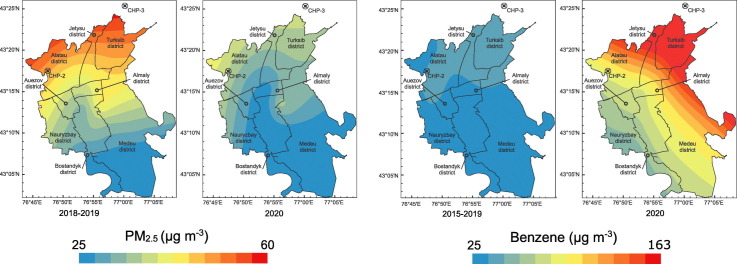- Record: found
- Abstract: found
- Article: not found
Assessing air quality changes in large cities during COVID-19 lockdowns: The impacts of traffic-free urban conditions in Almaty, Kazakhstan

Read this article at
Abstract
Number of cities worlwide experienced air quality improvements during COVID-19 lockdowns; however, such changes may have been different in places with major contributions from nontraffic related sources. In Almaty, a city-scale quarantine came into force on March 19, 2020, which was a week after the first COVID-19 case was registered in Kazakhstan. This study aims to analyze the effect of the lockdown from March 19 to April 14, 2020 (27 days), on the concentrations of air pollutants in Almaty. Daily concentrations of PM 2.5, NO 2, SO 2, CO, O 3, and BTEX were compared between the periods before and during the lockdown. During the lockdown, the PM 2.5 concentration was reduced by 21% with spatial variations of 6–34% compared to the average on the same days in 2018–2019, and still, it exceeded WHO daily limit values for 18 days. There were also substantial reductions in CO and NO 2 concentrations by 49% and 35%, respectively, but an increase in O 3 levels by 15% compared to the prior 17 days before the lockdown. The concentrations of benzene and toluene were 2–3 times higher than those during in the same seasons of 2015–2019. The temporal reductions may not be directly attributed to the lockdown due to favorable meteorological variations during the period, but the spatial effects of the quarantine on the pollution levels are evidenced. The results demonstrate the impact of traffic on the complex nature of air pollution in Almaty, which is substantially contributed by various nontraffic related sources, mainly coal-fired combined heat and power plants and household heating systems, as well as possible small irregular sources such as garbage burning and bathhouses.
Graphical abstract
Highlights
-
•
PM 2.5 concentration reduced by 21% with spatial variations of 6–34% compared to the average of the same days in 2018–2019
-
•
CO and NO 2 concentrations reduced by 49% and 35%, respectively
-
•
O 3 concentrations increased by 15% compared to the preceding 17 days before the lockdown
-
•
Concentrations of benzene and toluene were 2–3 times higher than in the same seasons of 2015–2019.

